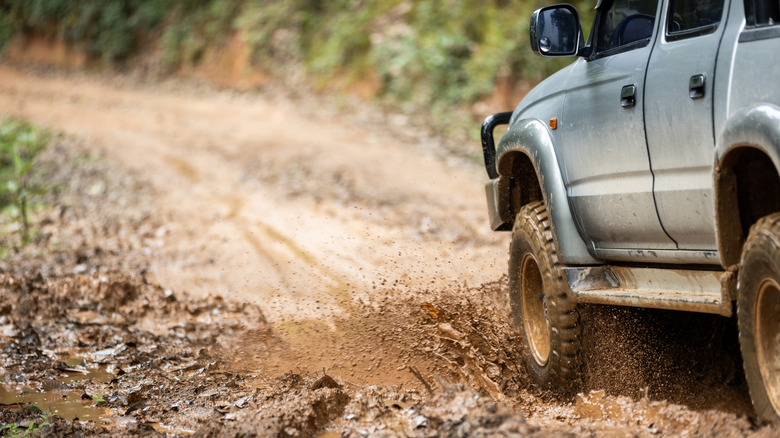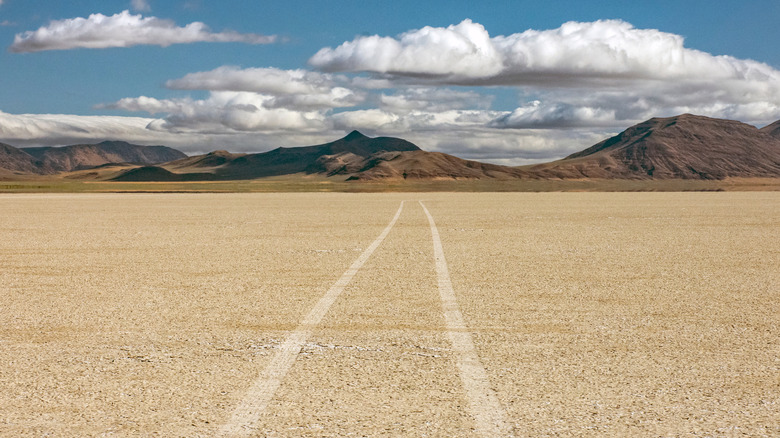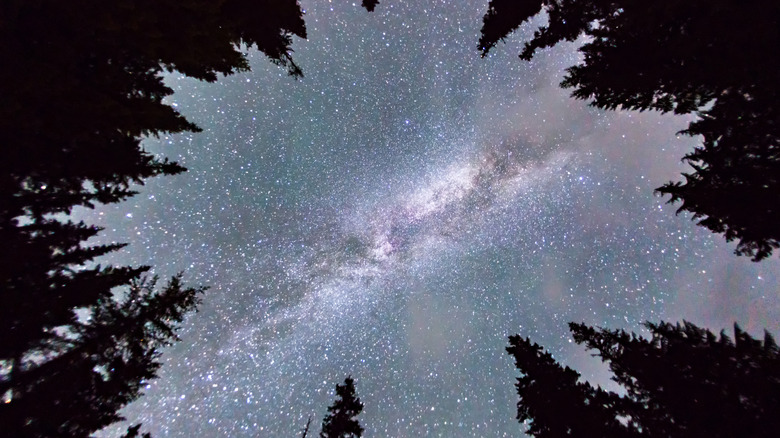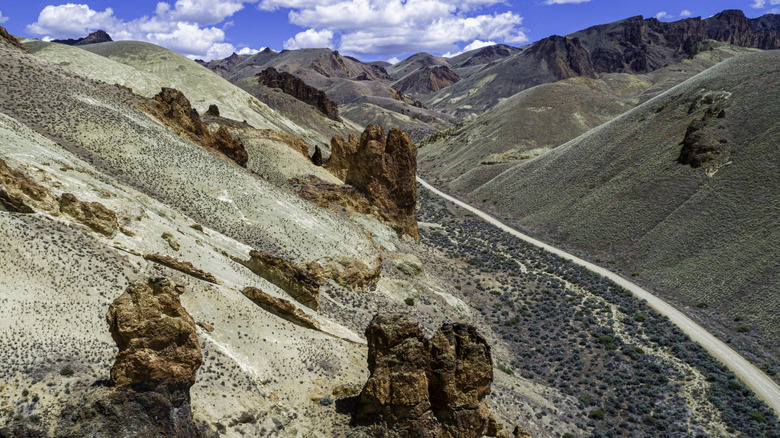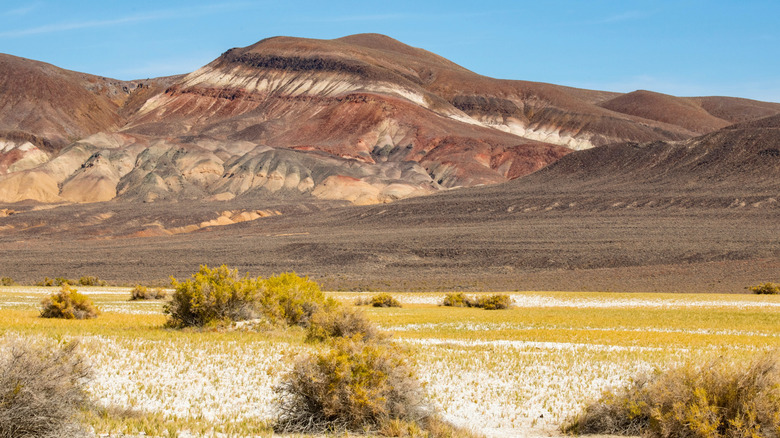The Great American Outback Trail Is A Breathtaking Off-Road Journey Through Four Western States
Four states, four segments, 23 to 44 days, 324 waypoints, 2,400 miles. That's what overlanders can expect out of the most remote off-roading route in the contiguous 48 states: the Great American Outback Trail. The overlanding track stretches across Oregon, California, Nevada, and Idaho and showcases the backcountry beauty of the American West to drivers with a keen sense of adventure — and all-wheel drive. The trail loops around an area comprising southeastern Oregon, northeastern California, northwestern Nevada, and southwestern Idaho. Guides recommend splitting the 2,400 miles into four segments, each taking between five and 12 days to travel. Following that recommendation, off-roaders would start and end in the pioneer town of Cedarville, California.
Cedarville is a tiny community in the northeast corner of the state, tucked into Surprise Valley in the Sierra Nevada Mountain Range. The town is a three-hour drive from Redding Regional Airport, but anyone looking to drive the Great American Outback Trail would likely want to haul their rigs from wherever it is they call home. Guides recommend traveling the route in an AWD vehicle with all-terrain tires. Some — but not all — segments are suitable for vans popular in the van-life movement, like the Mercedes-Benz Sprinter 4x4.
Broadly, the best time to drive the trail is summer to mid-fall, but some segments have narrower times for ideal off-roading. If you're trying to do it all in one go, September and October are the safest months to both avoid heat in the desert sections and avoid winter conditions in the higher altitudes.
From forest to desert on the Great American Overlook Trail
The first segment, climbing from northern California into Oregon, is also the shortest at 583 miles. Overlanders start by driving up into the Warner Mountains before entering the Modoc Plateau, a volcanic table where wild mustangs roam among volcanic rocks. Guides recommend that off-roaders detour to Lava Beds National Monument, where volcanic eruptions created rugged terrain with more than 800 caves. Overland Trail Guides suggests driving Cave Loop, a 3-mile trail where visitors can stop and see the entrances to 14 lava tunnels. "The number and variety of caves and the freedom you have to explore them is really quite incredible," one visitor wrote on Tripadvisor.
The route crosses into Oregon at the industrial town of Klamath Falls, after which drivers will spend some time driving through forest. Off-roaders can catch a glimpse above the dense canopy of trees at Bald Mountain Lookout, which offers views of forested hillsides and snowcapped peaks.
Fort Rock State Park marks the next juncture that's worth spending some time. Here, rising about 200 feet from Oregon's flat, high desert is Fort Rock. It's an enormous tuff ring, which is a shallow crater created by hydrovolcanic explosions. You can spend several hours in this area by visiting the park, as well as Fort Rock Homestead Village Museum, just a couple of miles farther along the trail. The museum consists of several preserved homestead-style structures from the early 1900s and takes visitors back to a time when homesteaders flocked to the area to claim federal lands for farms. Continuing on the drive, travelers will pass the Newberry National Volcanic Monument and Lava Lands Visitors Center in central Oregon. Then, the end of the first segment takes overlanders right through the historic district of the city of Bend.
Sand dunes and stargazing along this off-roading route
The Great American Outback Trail continues in its second segment from Bend into Christmas Valley, where visitors will find the largest inland shifting sand dune system in the Pacific Northwest. There, you're likely to meet fellow off-roaders enjoying the otherworldly setting. Farther along this 663-mile segment, overlanders will come upon Hart Mountain Hot Springs Campground, which Overland Trail Guides highlights as an exceptional overnight destination. Adjacent to the campground are the Antelope Hot Springs, which offer a unique and primitive soaking experience. A stone wall protects soakers from the wind, and a ladder into the springs makes it easy to get in and out. "We rode in on adventure motorcycles and camped near the open hot springs. Great way to relax after riding all day," an off-roader wrote on Tripadvisor.
Many overlanders enjoy the adventure and remote beauty that a route like the Great American Outback Trail offers. An inky black night sky — and the ability to see constellations clearly because of the distance from light pollution — is also a major draw. Stargazers take note: the Oregon Outback is the world's largest Dark Sky Sanctuary.
Later in this segment is Steens Mountain Loop, at an altitude of nearly 10,000 feet, where snow can be seen as late as July. (That's why it's recommended to drive part of the route in the fall, after snow from the previous winter has melted and before new snow falls). After the loop, overlanders will drive into the Alvord Desert, one of the most underrated destinations in Oregon for a quiet vacation. Segment two ends in Vale, a town that serves as an entrance to Owyhee Canyonlands.
Onto Idaho and Nevada on the Great American Outback Trail
The third segment of the Great American Outback Trail ties the fourth section as the longest, at 681 miles. It leads off-roaders from the deep canyons and rushing rivers of the Owyhee Canyonlands in Oregon to the lush forests of the Jarbidge Mountains in Nevada. In between, drivers traverse a sliver of southeastern Idaho. The initial portion of segment three is a haven for off-roaders with capable setups. The hills of the Owyhee Canyonlands have some unmaintained and bumpy roads taking those brave enough to traverse them into scenic sights such as Leslie Gulch, Succor Creek Natural Area, and Three Fingers Gulch. Rock spires jut up from the ground, and from some viewpoints, visitors can see miles upon miles of undeveloped land.
Off-roaders will then enter Idaho and its Snake River Plain, a wide, flat depression that takes up about a quarter of the state. In the region, overlanders cut through the village of Bruneau, which is known for a state park encompassing the largest single-structured sand dune in North America. "The dunes with the snow capped mountains in the distance is a postcard worthy view!" one traveler wrote of Bruneau Dunes State Park on Google.
After Bruneau, it's not long before the trail crosses over into the fourth state of the journey, Nevada. Drivers quickly arrive at the town of Jarbridge, noteworthy because of its status as the most isolated town in the state. Jarbridge sits deep in a canyon, surrounded by wilderness areas on all sides. The town's tiny Main Street includes a saloon, bed and breakfast, and trading post. After a stop there, off-roaders will navigate zig-zagging roads through the Jarbridge Mountains to where segment three ends and the final segment begins: Mountain City, Nevada.
A mountainous end to a scenic, 2,400-mile journey
Guides for the Great American Overland Trail acknowledge there's not much to see besides vast desert during the first part of segment four, another 681-mile route. Drivers exit the Jarbidge Mountains and roll through a vast landscape before reaching the Santa Rosa Mountains. "There's not a whole lot of anything in this part of Nevada than seemingly endless wide open spaces, so be sure to prepare accordingly," Overland Trail Guides suggests.
A reprieve from the mundanity comes in the form of Winnemucca, an overlooked Nevada city with tasty Basque cuisine. The free Humboldt Museum in Winnemucca tells the story of the area, the impact of European and Chinese immigrants, and its Native American heritage. Visitors will see fossils discovered in the Black Rock Desert, including a wooly mammoth skeleton and dinosaur bones. Beyond Winnemucca, off-roaders will be taken aback by the peculiarity of Nevada's Black Rock Desert. Between canyons and springs, there are miles of barren grassland. You can visit the dry, ancient lakebed of Black Rock Desert Wilderness as well as Black Rock Point, a 500-foot outcropping that provides a 360-degree view of the surrounding desert.
Overlanders will see a final spate of stunning sights as segment four enters the mountains again and nears its end, including Soldier Meadows Hot Springs, High Rock Canyon, the Pine Forest Range, Knott Creek Reservoir, Sheldon Wildlife Refuge, and Thousand Creek Gorge. Any one of these destinations would make a great pitstop if you're taking the trail a little slower. Farther on, drivers will come to Massacre Rim, a volcanic plateau that stargazers should try to see at night because of its status as a Dark Sky Sanctuary. The Great American Overland Trail crosses back into California — and its starting point of Cedarville — shortly after. To celebrate the end of a 2,400-mile journey, think about grabbing a drink and barbecue at Woody's Saloon & Restaurant, a gathering point for the small community.
